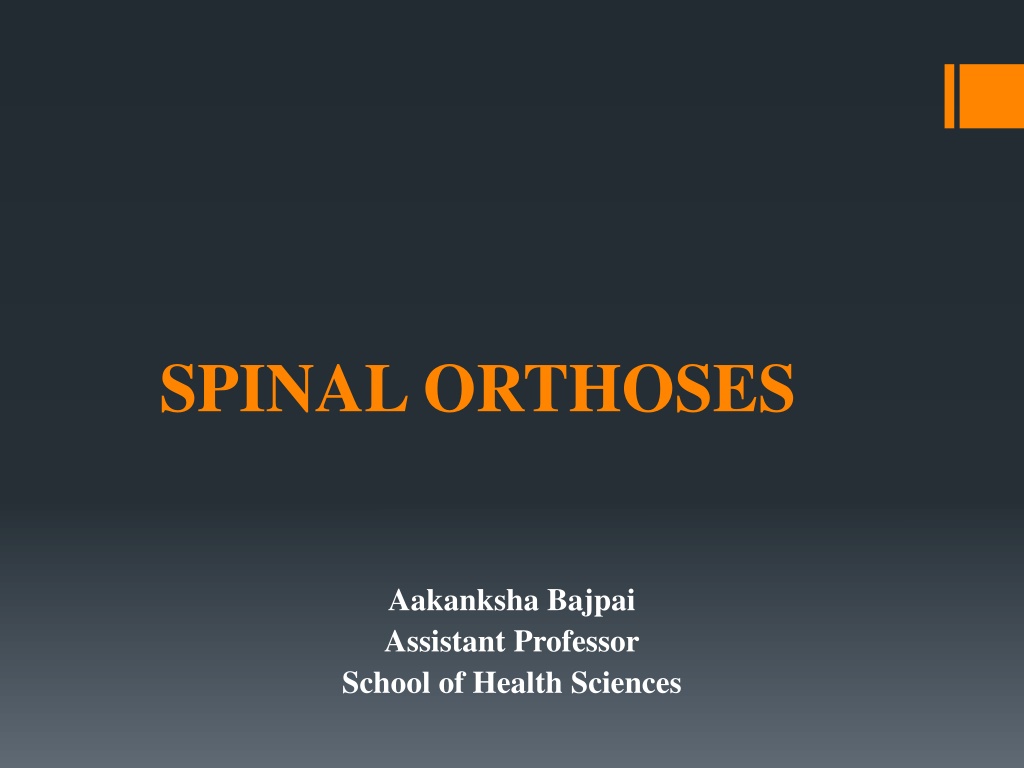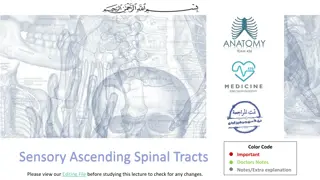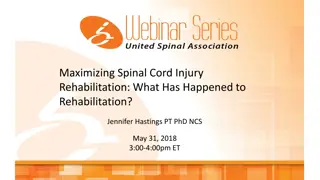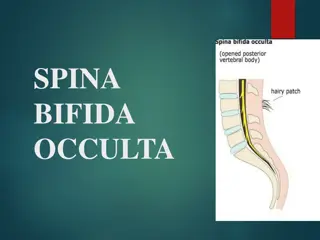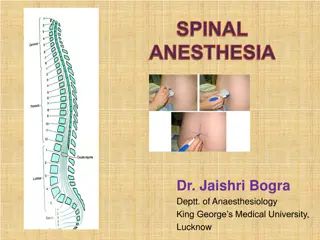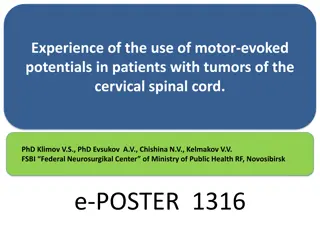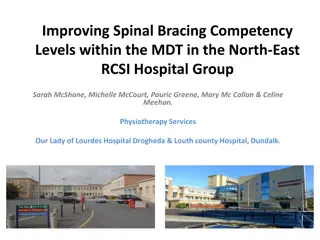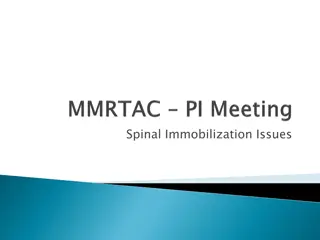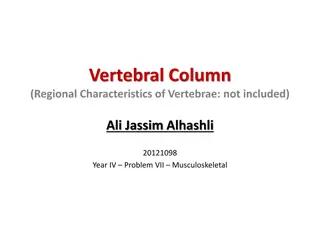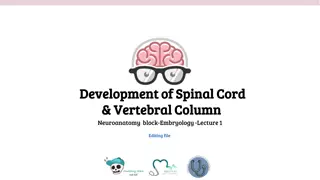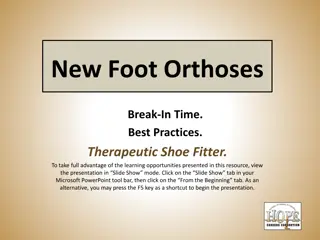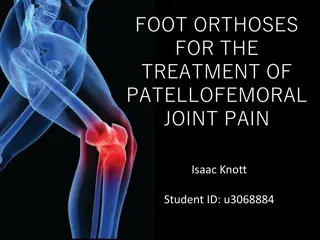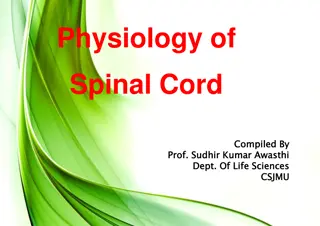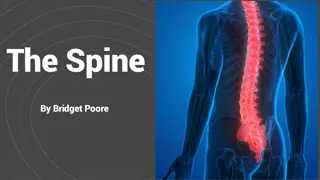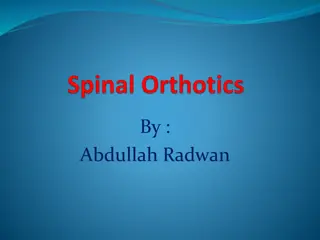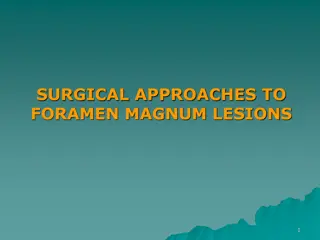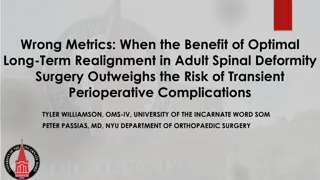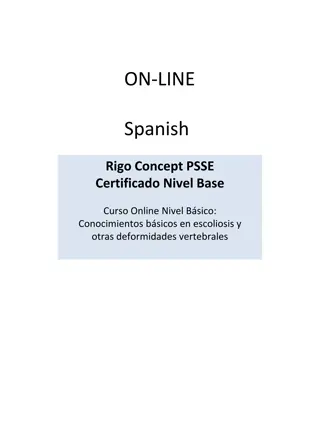Understanding Spinal Orthoses: Types, Uses, and Benefits
Spinal orthoses are back braces used to treat spinal disorders and injuries. They provide support, limit movement, and aid in healing. Orthoses are prescribed to realign the spine, immobilize it, limit mobility, and support weakened areas. Various types of orthoses are available based on the segments of the spine involved. They help in stabilizing spinal fractures, postoperative recovery, and managing degenerative changes. Proper usage and guidance from a physician are crucial for effective treatment.
Download Presentation

Please find below an Image/Link to download the presentation.
The content on the website is provided AS IS for your information and personal use only. It may not be sold, licensed, or shared on other websites without obtaining consent from the author. Download presentation by click this link. If you encounter any issues during the download, it is possible that the publisher has removed the file from their server.
E N D
Presentation Transcript
SPINAL ORTHOSES Aakanksha Bajpai Assistant Professor School of Health Sciences
SPINAL ORTHOSES A spinal orthosis is a back brace used to treat spinal disorders or after Spinal Cord Injury (SCI). All spinal orthotic devices need a physician order indicating direction for use and specifying when the patient should wear it. Unless otherwise indicated by a doctor, patients can take off their brace when laying down flat, as well as at night when they are sleeping. Orthoses are used to aid a weakened muscle group, correct a deformed body part, maintain the stability of a fractured spine, and protect the spine in cases of instability related to degenerative changes that result from aging.
Orthoses limit spinal movement, protect the spine during healing, and provide mechanical unloading. Orthoses are used in postoperative situations, to facilitate healing of surgical constructs used to stabilize gross spinal instability. When an orthosis is used to protect the spine during healing of a fracture or postoperatively after a surgical fusion, it generally is worn for 10 to 12 weeks.
OBJECTIVE OF SPINAL ORTHOSES Orthoses are designed to limit some or all movements of the spine: Flexion Extension Lateral bending Rotation
SPINAL ORTHOSES INDICATION Prescribed to: Realign the Spine Immobilize the Spine Limit Mobility Support WeakenedAreas of the Spine
GETTING OUT OF BED WITH BRACE (BRACE NOT SHOWN IN PICTURE)
TYPES OF SPINAL ORTHOSES Numerous designs of spinal orthoses are available, providing different degrees of support to different segments of the spine. Orthoses are named according to the body segments involved and the planes of movement restricted.
Head cervicothoracic orthoses (HCO) E.g.: Semirigid Minerva orthosis Cervical-Thoracic orthosis (CTO) E.g.: The sternal occipital mandibular immobilizer (SOMI) Cervical-thoracic-lumbro-sacral Orthoses (CTLSO) E.g.: Milwaukee Orthosis Thoracolumbosacral orthosis (TLSO) E.g.: Jewett
Cervical-Thoracic Orthosis (CTO) Consist of chin and occipital pieces that are connected by two to four adjustable metal uprights to sternal and back plates. Provide greater restriction of neck motion than collars do. E.g.: The sternal occipital mandibular immobilizer (SOMI)
Sternal Occipital Mandibular Immobilizer (SOMI) Parts Sternal plate One anterior strap to hold chin Two rigid metal rods from anterior to posterior to occiput support. Advantages No posterior post - can be used while patient is supine. Light weight for donning and doffing Controls flexion effectively at C1 C3
Indications Atlantoaxial instability caused by rheumatoid arthritis Neural arch fractures of C2, because flexion causes instability Contraindications The SOMI controls extension less effectively than do other orthoses. Flexion and extension control at C3-T1: better served with a Minerva.
SOMI Brace Fitting Instructions BraceApplication 1. ALWAYS apply brace while patient is lying flat on his/her back. 2. Apply the chest piece over the shoulders. 3. Attach the chin piece to the chest piece. 4. Occipital piece is then attached to the chest piece (slide on sideways underneath the neck). 5. Snap the chin and occipital pieces together. 6. Sit patient up. 7. Shoulder straps must be criss-crossed in the back, and then attached to the hooks on the front of the brace.
Brace Removal ONLY AT THE REQUEST OF THE DOCTOR brace is usually worn at all times. The SOMI should not be adjusted or removed without physician's consent. To remove the brace, reverse the application instructions. The headband or chin piece must be in place at all times. The headband can be worn for eating instead of the chin piece. The chin piece should be worn so that the head is looking forward, not up or down.
Cervical Thoracolumbosacral Orthoses (CTLSO) Basic components: Sternal plate Anterior and posterior uprights Mandibular support o Occipital support
Control Function: Restricts flexion/extension of the head and cervical spine Limits lateral flexion and rotation Through proper adjustment (elongation) can relieve c-spine from a portion of the weight of the head Indications for a CTLSO Brace: Thoracic Fractures T1-T6 Motion Limited: Restricts flexion/extension/lateral flexion & rotation
ACTLSO may also be known as a Milwaukee orthosis. It is a two-piece clamshell design. It consists of a customized pelvic girdle and a metal structure that extends to the neck. Use: To stabilize the head and neck as well as the spine after surgery or in the event of a spinal fracture to promote healing and decrease pain, and o to treat curves high in the upper back, such as kyphosis (hunchback).
Thoracolumbosacral Orthoses (TLSO) Thoracolumbosacral Orthoses Include: The clamshell thermoplastic body jacket, and The thoracolumbar extension orthosis or Jewett brace. There are a number of modifications of these two basic designs. These appliances apply three-point bending forces at the upper thorax and pelvis and at the midportion of the brace across the thoracolumbar junction
This class of orthotic is best suited for restricting thoracolumbar and lumbar gross-body motion and poorly controls low lumbar and sacral segments. Molded appliances are particularly useful for thoracolumbar junction trauma in which the total contact feature helps to control lateral bending and rotation.
For fractures between T6 and L3. Provide support and immobilization of the thoracic and lumbar regions following various surgical procedures/traumatic injuries. Help in treatment of post-operative thoracic/lumbar fusion, laminectomy or discectomy, compression fractures, degenerative disc disease, osteoporosis, single column spinal instability immobilization, and facet syndrome.
Custom TLSO is a molded plastic body orthosis. It provides control of flexion, extension, lateral bending, and rotation, using a three-point pressure system and circumferential compression until healing can occur.
TLSO (Clam shell) Application Instructions 1. Ideally the orthosis should be worn on top of a T-shirt, nightshirt, or long undershirt to allow for ventilation. 2. Log roll the patient to their preferred side. 3. Put on back section of the brace first, by sliding edge of brace and Velcro straps under the patient's side. The bottom of the orthosis should be about one inch below the midpoint of the bum and the mid-line of the orthosis should be slightly more toward the side that the patient is lying on (approximately 1" beyond the spine).
Roll patient flat onto their back, making sure that the shoulders and hips are square. At this point, the orthosis may need to be pulled so that the orthosis is lying centered on the back. Feel the sides to make sure that the orthosis comes up equally on either side of the body. Never lift the hipsATANYTIME.
Next place the front section of the orthosis on the patient. This section should be placed low enough so that the belly is covered as much as possible. This may mean that the chest section is lower than normal, but it will move up once the brace is tightened. The straps should be done up from the bottom up, loosely at first, and then pulled tight. The patient should be able to breathe normally, but NOT be able to take a deep breath through the belly.
How it should look: When wearing the brace in sitting, it should sit on top of the thighs, and the back of the brace should be about 1" above the seat of a firm chair. In standing, the back section should end at the height of the curve in the buttocks, and the midline should be within 1" of either side of the spine. If it is not there, it should be reapplied. There needs to be a gap between the front and the back section. If these sections touch on both sides, the brace needs to be adjusted. Please call your local orthotic supplier to arrange to have this adjustment made.
TLSO (Clam shell) Removal Instructions How to remove Lie down flat on the back. Undo Velcro straps. Remove front section first. Log roll patient to most comfortable side. Slide out back section. When to wear brace The brace should be worn whenever the patient is sitting up or standing. It can be off when they lie down. It should be applied and taken off in a lying position.
TLSO (Clam shell) Care Instructions Shower/Bathing The brace can be worn in the water. After a shower or bath, remove the brace, towel dry and let air dry for a short time (15- 30 minutes). We usually recommend washing at night, so the brace can dry completely. Care & Cleaning It is recommend to wash the brace at least once a week with soap and water, a washcloth or sponge. The soap residue must be rinsed off completely. After cleaning, towel dry the brace and let stand for a short time (15- 30 minutes).
Jewett Hyperextension Thoracolumbosacral Orthosis (Jewett TLSO) oIt is prefabricated and consists of an anterior and a lateral frame to which pads are attached laterally and at the sternal and suprapubic areas. oThe system uses a 3-point pressure system to control flexion of the spine. oIt applies two posteriorly directed forces: The anterior pads place pressure over the sternum and pubic symphysis. The posterior pad places opposing pressure in the midthoracic region.
Jewett Instructions How to apply 1. Ideally the orthosis should be worn on top of a T-shirt. 2. Lie on the bed, place the orthosis onto chest, and roll onto the right side. 3. Put the back pad & strap behind the back and slide the metal or plastic clasp under the right side. 4. Roll onto back and centre the front section into place over the stomach and chest.
5. To fasten the orthosis, hold it in place with the left hand. With the right hand, use the thumb loop to pull the clasp forward tightly, and then in towards the stomach, then down. This locks the clasp into the hook. Now turn the tab so that the back strap shortens, tightening the orthosis, approximately 10 turns. 6. The orthosis should feel tight, and look symmetrical. 7. Sometimes the attaching of the clasp pushes the Jewett to one side. If this happens, try to overcorrect for this before tightening the clasp.
8. If the sternal pad can be pulled more than 1.5 cm (approximately the thickness of a finger) away from the chest while lying or standing, then the clasp should be tightened. 9. For a proper fit the upper pad should rest on the sternum and the lower bar should just touch the thigh when sitting. If the patient feels excessive pressure on the chest, the patient should physically straighten his or her back, keeping the shoulders back and not leaning into the orthosis for support. The orthosis should act as a reminder that the patient is bending forward and compromising his or her back.
How to remove Lay down flat on your back. Loosen the clasp by approximately 10 turns. Put the left hand on the orthosis to hold it in place, then with the right thumb, pull the thumb loop of the clasp forward tightly, then in towards the stomach, then upwards towards the head to remove clasp from the hook. Roll onto the right side and pull plastic clasp out from under the right side. Take off the orthosis. When to wear orthosis The orthosis should be worn when sitting up or standing. It can be taken off when lying flat (the patient does not have to sleep in it unless the Dr. specifies this). It should be applied and taken off in a lying position.
References (American Academy of Neurology) Michael Selzer M.D., Bruce Dobkin M.D. (2008) Spinal Cord Injury:A Guide for Patients and Families, 1 edn., New York: Demos. AMPOS https://info923422.wixsite.com/ampos/device-information-sheets (Accessed: 2nd September 2019). Device Information Sheets (2016) Corset, Available at: AMPOS Device Information Sheets (2016) CTLSO (Cervical-thoracic-lumbo-sacral Orthosis) Information, Available at: https://info923422.wixsite.com/ampos/device-information-sheets (Accessed: 2nd September 2019). AMPOS Device Information Sheets (2016) Hip Stabilizing Brace (Hip Spica), Available at: https://info923422.wixsite.com/ampos/deviceinformation-sheets (Accessed: 2nd September 2019). AMPOS https://info923422.wixsite.com/ampos/device-information-sheets (Accessed: 2nd September 2019). Device Information Sheets (2016) Jewett, Available at: AMPOS Device Information Sheets (2016) LSO (Lumbo-Sacral Orthosis) Information, Available at: https://info923422.wixsite.com/ampos/device-information-sheets (Accessed: 2nd September 2019).
